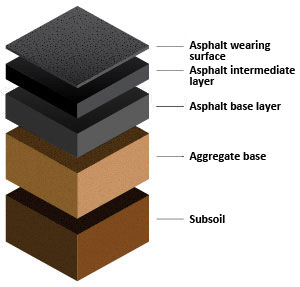All too often, when buildings are planned, there has been little thought given to the pavement around it.
So, when the Innovation Center and Research Lab was opened in Indianapolis last summer, it bucked the trend.
Here, it was not just the facility itself which had been built to exacting specifications. It was also the surrounding parking lots and paving.
What can commercial asphalt companies operating in California learn from them?
1.THE STRUCTURE DESIGN
The center’s roads were designed with 8 inches of compacted 36 mm top aggregate base and 4 inches of 19 mm Superpave.
Its steel slag SMA is the same as the racing surface of the Indianapolis Motor Speedway main oval, however, with better binder.
The center’s parking lot had 6 inches of compacted 53 aggregate and 3 inches of 19mm Superpave.
2.POROUS PAVING
To help with the problem of flooding in parking lots, the asphalt was treated with a special porous paving layer.
This comprised of about one fifth air void, to help the water drain from it when it rains.
Additionally, these pores have a collection basin under the surface, which will release the water into drainage pools.
This stops flooding in the parking areas from becoming problematic.

3.POLYMER MODIFIED ASPHALT
The roads and the parking lots had two different polymer asphalt systems.
The parking lots had a 1.5 inch surface lift of 9.5 mm and a PMA PG 70-22.
4.MIX PERFORMANCE TESTING
The surface was tested – both IFIT and Hamburg (low temperature cracking and high temperature rutting, respectively). It performed highly. LOW
5.PERMEABILITY
All the paving surfaces had an emulsion applied to them, to fill the voids.
This emulsion was specially made to fill the voids on the surface. When it is applied, it should leave only a trace of its residue on the paving surface and will not harm the friction of the pavement.
6.LONGITUDINAL JOINT SEALANT
In parking lots, there are a lot of joints which have areas around them with high air void levels. This means they are quite vulnerable to raveling and cracking.
These have been sealed with a new technique called Longitudinal Joint Sealant.
It is designed to fill those voids close to the joints, helping to improve its long wearing properties and stop it from re-opening.
The sealant is also then applied to the concrete curb and helps maintain a pliable inner layer, which keeps the joint that runs along the concrete and the asphalt impermeable.
7.BIRD BATH ELIMINATION
When the roads and parking lots were surveyed for their ability to drain excess water without flooding occurring, it was found only a few spots still had ponding in the rain.
In those areas, the surface was milled until it was sloped correctly to allow the water to drain away adequately.
Then, the final surface lift was laid.
IN BRIEF
So, instead of the paved areas to the new development being an afterthought and something that was simply placed there without any real consideration being given to it, we can see that the new center had been properly designed and treated.
This is something which should be of interest to all business and commercial owners looking to build new premises. It is also something which any asphalt paving contractors should want to look at closely, too.
By applying a little forethought, with some innovation, first rate engineering and the use of premium grade materials, a high quality parking lot and paved area was achieved for the new center.
As well as looking good, the pavements and asphalt surrounding the center now can be expected to last longer and out perform other business’s parking lots, by some considerable degree.
